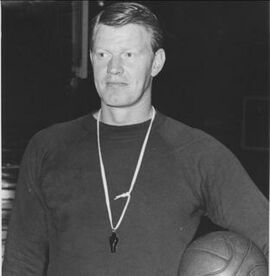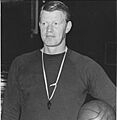Johnny Kerr facts for kids

Kerr coaching the Bulls in 1966
|
|
| Personal information | |
|---|---|
| Born | July 17, 1932 Chicago, Illinois, U.S. |
| Died | February 26, 2009 (aged 76) Chicago, Illinois, U.S. |
| High school | Tilden (Chicago, Illinois) |
| Listed height | 6 ft 9 in (2.06 m) |
| Listed weight | 230 lb (104 kg) |
| Career information | |
| College | Illinois (1951–1954) |
| NBA Draft | 1954 / Round: 1 / Pick: 6th overall |
| Selected by the Syracuse Nationals | |
| Pro career | 1954–1966 |
| Career history | |
| As player: | |
| 1954–1965 | Syracuse Nationals / Philadelphia 76ers |
| 1965–1966 | Baltimore Bullets |
| As coach: | |
| 1966–1968 | Chicago Bulls |
| 1968–1970 | Phoenix Suns |
| Career highlights and awards | |
As player:
As coach:
|
|
| Career statistics | |
| Points | 12,480 (13.8 ppg) |
| Rebounds | 10,092 (11.2 rpg) |
| Assists | 2,004 (2.2 apg) |
John Graham Kerr (born July 17, 1932 – died February 26, 2009) was a famous American basketball player. People also knew him as Red Kerr. He was a player, coach, and even a sports announcer. Red Kerr spent over 60 years involved in basketball!
Kerr was a tall player, standing 6 feet 9 inches (2.06 m) and weighing 230 pounds (104 kg). He played as a center. He was a star player for the University of Illinois from 1951 to 1954. Later, he became a three-time All-Star in the NBA. He even won an NBA championship with the Syracuse Nationals.
Red Kerr was known for being one of the first "iron men" in the NBA. This means he played in many games without missing any. From 1954 to 1965, he played in 917 games in a row! This was a record for 17 years. He scored about 13.8 points and grabbed 11.2 rebounds per game during his 12 seasons. He was a very steady player and was known as one of the best big players in the league.
After he stopped playing, Kerr became a coach. He coached the Chicago Bulls and the Phoenix Suns in their very first seasons. His first Bulls team in 1966-67 surprised everyone. They made it to the playoffs, which was a first for a new team in a major sport!
Red Kerr finished his career as a TV announcer for the Chicago Bulls for 33 years. He was a well-known voice during the Bulls' amazing championship years in the 1990s.
Contents
Growing Up in Chicago
Kerr grew up in Chicago, Illinois. He lived in the 67th and Racine neighborhood. As a kid, he often played 16-inch softball at Ogden Park. He also dreamed of working in a foundry, which is a place where metal is melted and shaped. He became very good at this while studying at Tilden Technical High School.
At first, Kerr loved soccer the most. But in his last year of high school, he grew eight inches! This big growth spurt, along with some encouragement from his basketball coach and principal, made him focus on basketball. He became a key player for the Tilden Tech Blue Devils. In his only season with the team, he led them to win the 1950 Chicago Public League championship.
College Basketball Journey
After finishing high school in January 1950, Kerr planned to go to Bradley University. However, a freshman player from the University of Illinois named Irv Bemoras visited him. Irv told him how great it was to play for coach Harry Combes and the Fighting Illini. Kerr visited the campus and quickly changed his mind.
Kerr was known for his funny jokes. Once, when asked about studying Chaucer in college, he joked that they hadn't met yet, but he expected to see him at a fraternity party!
Kerr started playing for the Illinois varsity team in the 1951–52 season. Even though some top players had left, Kerr and his teammates won the Big Ten Conference championship. They had a great record of 12 wins and 2 losses in the conference. Overall, they won 22 games and lost only 4. They even made it to the NCAA Tournament's Final Four! They beat Dayton and Duquesne. They lost a close game to St. John's but won the third-place game. Kerr led the team by scoring 13.7 points per game. The team finished the season ranked No. 2 in the country.
In the 1952–53 season, Kerr continued to play well. He led the team in scoring with 17.5 points per game. The team finished second in the Big Ten. By his senior year, Kerr was 6-foot-9 and played as a full-time center. He had his best individual season, scoring 25.3 points per game. In total, Kerr scored 1,299 points during his college career. In 2004, he was chosen for the University of Illinois All-Century Team.
Playing in the NBA
Syracuse Nationals and Philadelphia 76ers (1954–1965)
In 1954, the Syracuse Nationals picked Johnny Kerr as the sixth player in the NBA draft. At first, he played a smaller role on the team. But soon, his coach trusted him more. He ended up averaging 10.5 points and 6.6 rebounds per game.
In the playoffs, Kerr became a key player. In his first playoff game, he scored 27 points and grabbed 14 rebounds! The Nationals went on to beat the Boston Celtics. Then, they defeated the Fort Wayne Pistons in the NBA Finals. This win gave the Syracuse Nationals their first and only NBA championship.
Even though Hall of Famer Dolph Schayes was the biggest star, Kerr was also very important. He was chosen for the All-Star team three times (1956, 1959, 1963). He was great at both scoring and passing. He was also a strong rebounder.
Baltimore Bullets (1965–1966)
In 1965, Kerr was traded to the Baltimore Bullets. He played one season there, averaging 11.0 points and 8.3 rebounds. After this season, the new Chicago Bulls team picked him in a special draft. However, Kerr decided to stop playing and become the head coach for his hometown team, the Chicago Bulls.
He ended his playing career with 12,480 points and 10,092 rebounds. His record for most consecutive games played (844) stood until 1982.
Coaching Career Highlights
Chicago Bulls (1966–1968)
After becoming the Bulls' head coach, Kerr helped bring in important players like Jerry Sloan and Guy Rodgers. Many people thought the new Bulls team wouldn't win many games. One player-coach even said they'd be lucky to win 20 games.
But Sloan and Rodgers helped the "Baby Bulls" surprise everyone! They finished their first season with 33 wins and 48 losses. They even made it to the playoffs! This was the first time a brand-new team in a major sport had ever done that. Because of this amazing success, Johnny Kerr won the NBA Coach of the Year Award. He is the only coach to win this award with a losing record.
The next season was tougher for the Bulls. They struggled at the start. Even though they made the playoffs again, they lost in the first round. Because of the team's struggles and disagreements with the owners, Kerr left the Bulls after that season.
Phoenix Suns (1968–1970)
Kerr quickly found another coaching job. Two months later, his friend Jerry Colangelo hired him to be the first head coach for another new team, the Phoenix Suns.
The Suns didn't have as much success as the Bulls. They finished last in their division with only 16 wins and 66 losses. The next season, the team started a bit better. But after 38 games, Kerr was asked to resign as coach. He stayed with the team for the rest of the season, working as a radio announcer.
Broadcasting and Front Office Work
After coaching, Kerr worked for the Virginia Squires basketball team for two years. Then, he returned to the Chicago Bulls in their front office. In 1975, the Bulls' announcer suggested that Kerr join him to give commentary during games. Kerr became a popular color commentator and stayed in that role until 2008.
As a broadcaster, Kerr was there for all six of the Bulls' championships in the 1990s. He also saw Michael Jordan's entire career with the team. He was famous for his excited call on "The Shot". This was Jordan's game-winning basket in a playoff game in 1989. Kerr famously yelled, "The Bulls win it! We win it! ... Whooo!"
Kerr and Jordan had a fun pre-game tradition. Before each game, Jordan would go to Kerr's seat and playfully clap talcum powder in front of him. Jordan later said he just wanted to mess up Kerr's nice suit a little!
Towards the end of his life, Kerr made fewer public appearances because of his battle with prostate cancer. The Bulls honored him in February 2009. They unveiled a sculpture of him at the United Center. He also received a special award for his lifetime achievements in basketball. The mayor of Chicago even declared February 10, 2009, "Johnny Red Kerr Appreciation Day."
Final Days
Johnny Kerr passed away from prostate cancer on February 26, 2009. He was 76 years old.
Honors and Awards
- 1952 – Second Team All-Big Ten
- 1952 – NCAA Final Four All-Tournament Team
- 1952 – Honorable Mention All-American
- 1953 – Second Team All-Big Ten
- 1953 – Honorable Mention All-American
- 1953 – First Team All-Big Ten
- 1954 – Second Team All-American
- 1954 – Illini Most Valuable Player
- 1954 – Big Ten Player of the Year
- 1954 – Chicago Tribune Silver Basketball Award
- 1967 – NBA Coach of the Year Award
- 1973 – Illinois Basketball Coaches Association's Hall of Fame (as a player)
- 2004 – Illini Men's Basketball All-Century Team
- 2007 – 100 Legends of the IHSA Boys Basketball Tournament
- 2008 – Illini men's basketball honored jersey
- 2018 – Illinois Athletics Hall of Fame
Images for kids


